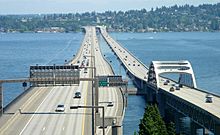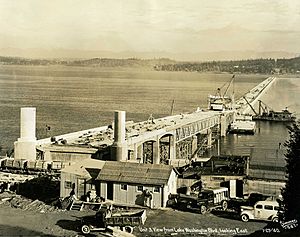Lacey V. Murrow Memorial Bridge facts for kids
Quick facts for kids Lacey V. Murrow Memorial Bridge |
|
|---|---|

The Lacey V. Murrow Memorial Bridge (right) and the Homer M. Hadley Memorial Bridge (left) in 2005, looking east toward Mercer Island
|
|
| Carries | |
| Crosses | Lake Washington |
| Locale | Seattle / Mercer Island, Washington, U.S. |
| Maintained by | Washington State Department of Transportation |
| Characteristics | |
| Design | Pontoon bridge |
| Total length | 6,620 ft (2,020 m) |
| History | |
| Opened | July 2, 1940 |
| Rebuilt | September 12, 1993 |
The Lacey V. Murrow Memorial Bridge is a special kind of bridge called a floating bridge. It's located in the Seattle area of Washington state in the U.S. This bridge is one of two floating bridges that carry Interstate 90 across Lake Washington. It connects Seattle to Mercer Island.
The Murrow Bridge carries four lanes of traffic heading east. Another bridge next to it, the Homer M. Hadley Memorial Bridge, carries traffic going west. The Murrow Bridge is the second-longest floating bridge in the world, stretching about 6,620 ft (2,020 m) (that's over a mile!). The longest floating bridge is also on Lake Washington, a few miles north.
The first Murrow Bridge opened in 1940 and was first called the Lake Washington Floating Bridge. It was renamed in 1967 to honor Lacey V. Murrow. The original bridge closed in 1989, and the current bridge opened in 1993 after being rebuilt. This bridge is an important landmark for the City of Seattle and is also recognized as a National Historic Civil Engineering Landmark.
Contents
Building the Bridge: A Look Back
The idea for this bridge came from an engineer named Homer Hadley in 1921. A man named George Lightfoot worked very hard to make the bridge happen, starting in 1930. He even got support from a businessman named Miller Freeman.
Many people were unsure about building a floating bridge. The Seattle Times newspaper even criticized the idea at first, but later apologized before the bridge opened. Construction began on January 1, 1939. The Washington State Toll Bridge Authority finished building it in 1940. The whole project cost about $9 million, with some money coming from a special loan.
Opening and Early Days
The Lake Washington Floating Bridge opened on July 2, 1940. It carried a part of the Sunset Highway, which was then called US 10. When the bridge opened, the ferry boats that carried cars between Seattle and Mercer Island stopped running.
People had to pay a fee, called a toll, to cross the bridge. Cars paid 25 cents, trucks paid more, bicycles paid 10 cents, and even pedestrians paid 5 cents. These tolls were collected on Mercer Island. The tolls were removed on July 2, 1949, because the loans used to build the bridge were paid off much earlier than expected.
Who Was Lacey V. Murrow?
In 1967, the bridge was renamed the Lacey V. Murrow Memorial Bridge. Lacey V. Murrow (1904–1966) was an important person. He was the second director of the Washington State Highway Department. He was also a highly respected officer in the United States Air Force during World War II, where he was a bomber pilot. He became a brigadier general. He was also the older brother of the famous CBS news reporter, Edward R. Murrow.
Challenges with the Original Design
The first bridge had a part in the middle that could move to let large boats pass. This design created a bump in the road, and cars had to swerve a bit as they crossed it. There was also a system that changed which lanes went which way during busy times. This could be confusing and led to many accidents. As more and more cars used the bridge, these problems became worse.
Because of these issues, a new, parallel bridge was needed. The Homer M. Hadley Memorial Bridge was finished in 1989. After the new bridge opened, the 49-year-old Murrow Bridge closed on June 23, 1989, for major repairs and updates.
The 1990 Sinking Event
On November 25, 1990, while the Murrow Bridge was being repaired, a large section of it sank. This happened because of several mistakes made during the renovation work. Workers were using high-pressure water to remove old parts of the bridge's surface. This water was dirty and could not go into Lake Washington.
Engineers decided to store the dirty water inside the bridge's floating sections, called pontoons. To do this, they removed the special watertight doors from the pontoons. Then, a big storm hit over the Thanksgiving holiday weekend in November 1990. Rain and lake water filled some of the pontoons.
Workers noticed the bridge was sinking on November 24 and tried to pump water out. But on November 25, a 2,790-foot (850 m) section of the bridge sank. It dumped the dirty water and tons of bridge material into the lake. No one was hurt or killed because the bridge was closed for repairs. The sinking happened slowly and was even filmed live on TV. This disaster caused $69 million in damages. It also delayed the bridge's reopening by 14 months. The rebuilt Lacey V. Murrow Memorial Bridge finally opened on September 12, 1993.
What We Learned from the Sinking
This wasn't the first time a floating bridge in Washington had problems. The Hood Canal Bridge also sank in 1979 under similar conditions. These events taught engineers important lessons about how to design and maintain floating bridges to make them safer and stronger. For example, the Evergreen Point Floating Bridge, built in 1963, was later replaced with a new floating span in 2016, partly due to these lessons.
See also
 In Spanish: Puente conmemorativo de Lacey V. Murrow para niños
In Spanish: Puente conmemorativo de Lacey V. Murrow para niños
- List of bridges documented by the Historic American Engineering Record in Washington (state)
- List of bridges in Seattle
- Homer M. Hadley Memorial Bridge



